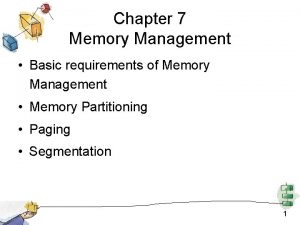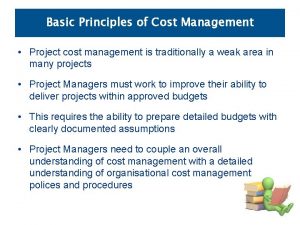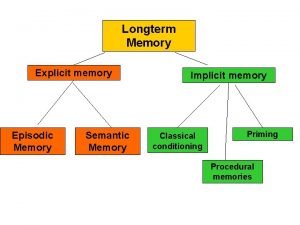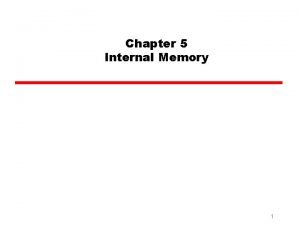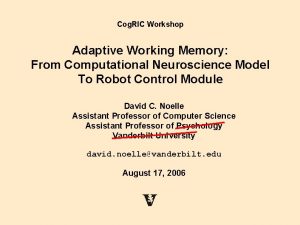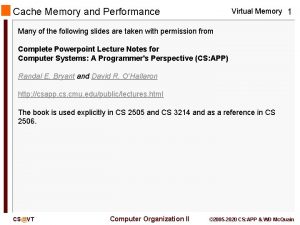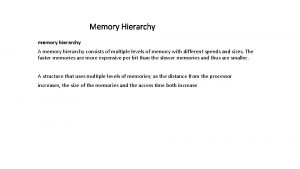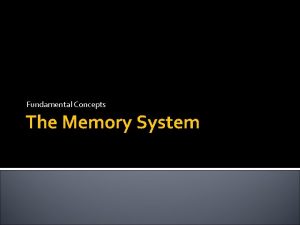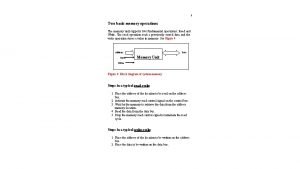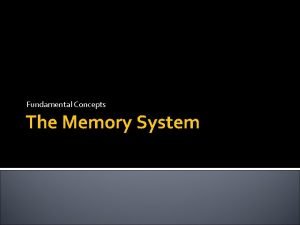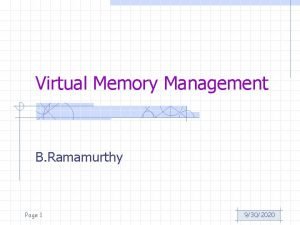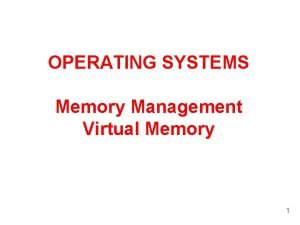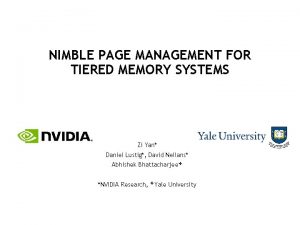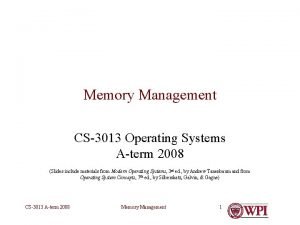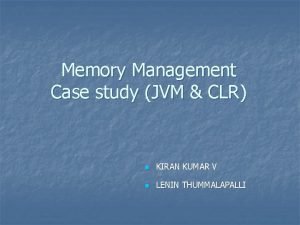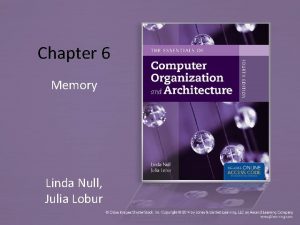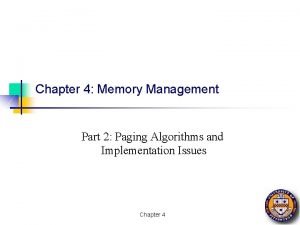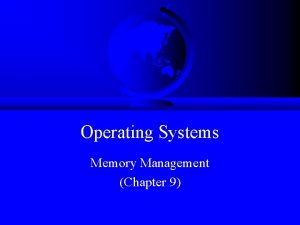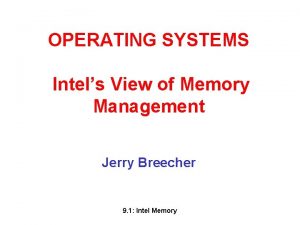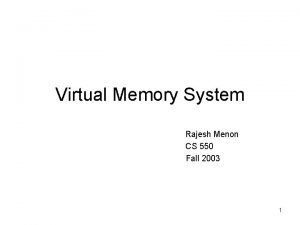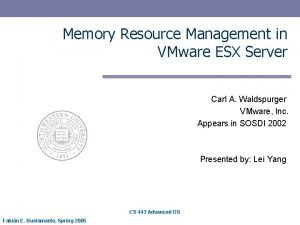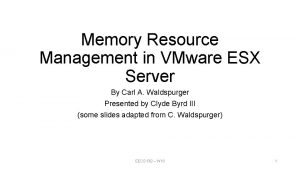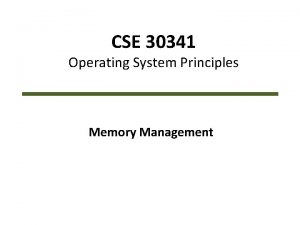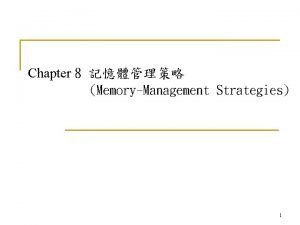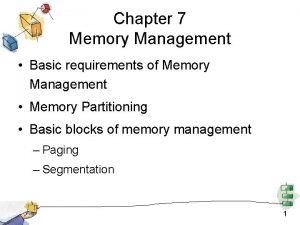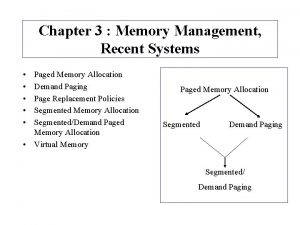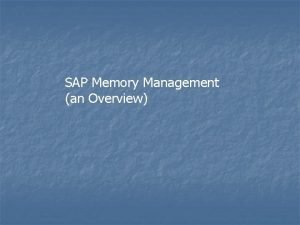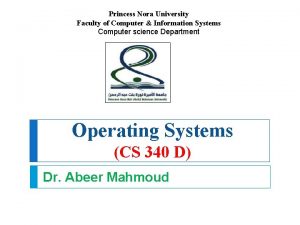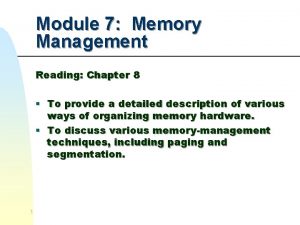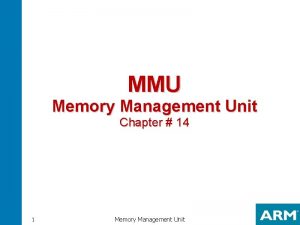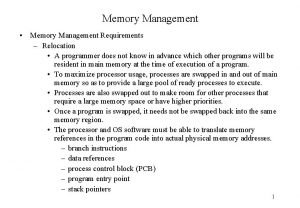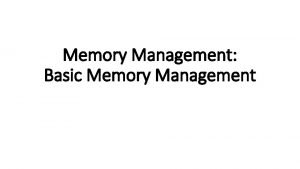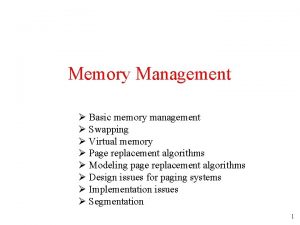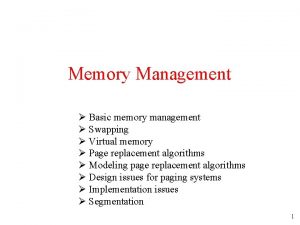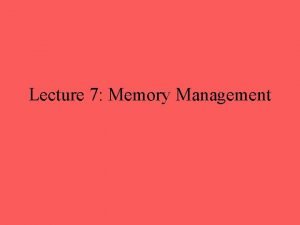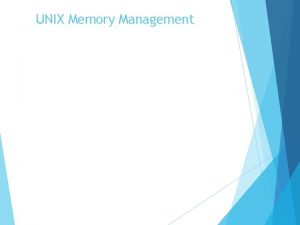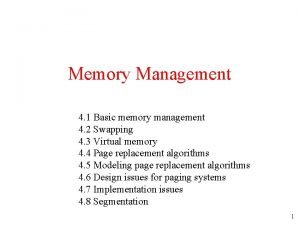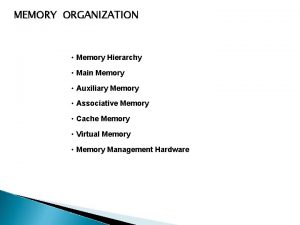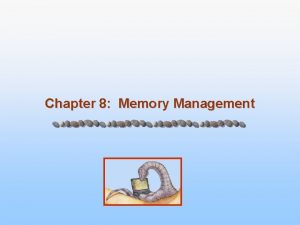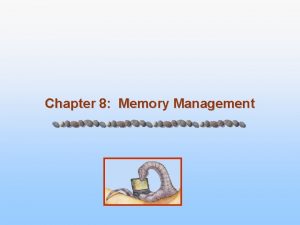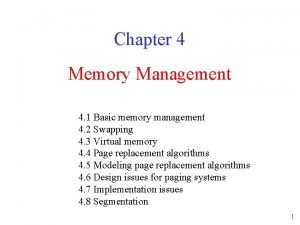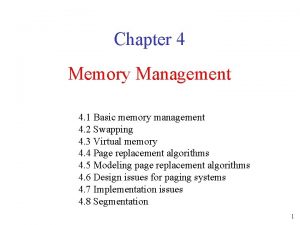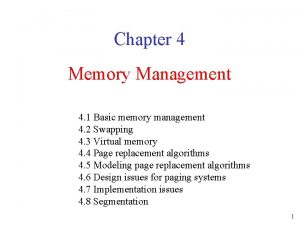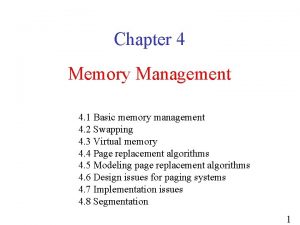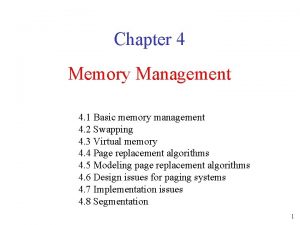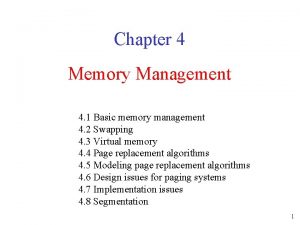Chapter 4 Memory Management 4 1 Basic memory

Chapter 4 Memory Management 4. 1 Basic memory management 4. 2 Swapping 4. 3 Virtual memory 4. 4 Page replacement algorithms 4. 5 Modeling page replacement algorithms 4. 6 Design issues for paging systems 4. 7 Implementation issues 4. 8 Segmentation 1

Memory Management • Ideally programmers want memory that is – large – fast – non volatile • Memory hierarchy – small amount of fast, expensive memory – cache – some medium-speed, medium price main memory – gigabytes of slow, cheap disk storage • Memory manager handles the memory hierarchy 2

Basic Memory Management Monoprogramming (uniprogramming) without Swapping or Paging Three simple ways of organizing memory - an operating system with one user process 3

Multiprogramming with Fixed Partitions • Fixed memory partitions – separate input queues for each partition – single input queue 4

Modeling Multiprogramming Degree of multiprogramming CPU utilization as a function of number of processes in memory 5

Relocation and Protection • Cannot be sure where program will be loaded in memory – address locations of variables, code routines cannot be absolute – must keep a program out of other processes’ partitions • Use base and limit values – address locations added to base value to map to physical address – address locations larger than limit value is an error 6

Swapping (1) Memory allocation changes as – processes come into memory – leave memory Shaded regions are unused memory 7

Swapping (2) • Allocating space for growing data segment • Allocating space for growing stack & data segment 8

Memory Management with Bit Maps • Part of memory with 5 processes, 3 holes – tick marks show allocation units – shaded regions are free • Corresponding bit map • Same information as a list 9

Memory Management with Linked Lists Four neighbor combinations for the terminating process X 10

Virtual Memory Paging (1) The position and function of the MMU 11

Paging (2) The relation between virtual addresses and physical memory addresses given by page table 12

Page Tables (1) Internal operation of MMU with 16 4 KB pages 13

Page Tables (2) Second-level page tables Top-level page table • 32 bit address with 2 page table fields • Two-level page tables 14

Page Tables (3) Typical page table entry 15

TLBs – Translation Lookaside Buffers A TLB to speed up paging 16

Inverted Page Tables Comparison of a traditional page table with an inverted page table 17

Page Replacement Algorithms • Page fault forces choice – which page must be removed – make room for incoming page • Modified page must first be saved – unmodified just overwritten • Better not to choose an often used page – will probably need to be brought back in soon 18

Optimal Page Replacement Algorithm • Replace page needed at the farthest point in future – Optimal but unrealizable • Estimate by … – logging page use on previous runs of process – although this is impractical 19

Not Recently Used Page Replacement Algorithm • Each page has Reference bit, Modified bit – bits are set when page is referenced, modified • Pages are classified 1. 2. 3. 4. not referenced, not modified not referenced, modified referenced, not modified referenced, modified • NRU removes page at random – from lowest numbered non empty class 20

FIFO Page Replacement Algorithm • Maintain a linked list of all pages – in order they came into memory • Page at beginning of list replaced • Disadvantage – page in memory the longest may be often used 21

Second Chance Page Replacement Algorithm • Operation of a second chance – pages sorted in FIFO order – Page list if fault occurs at time 20, A has R bit set (numbers above pages are loading times) 22

The Clock Page Replacement Algorithm 23

Least Recently Used (LRU) • Assume pages used recently will used again soon – throw out page that has been unused for longest time • Must keep a linked list of pages – most recently used at front, least at rear – update this list every memory reference !! • Alternatively keep counter in each page table entry – choose page with lowest value counter – periodically zero the counter 24

Simulating LRU in Software (1) LRU using a matrix – pages referenced in order 0, 1, 2, 3, 2, 1, 0, 3, 2, 3 25

Simulating LRU in Software (2) • The aging algorithm simulates LRU in software • Note 6 pages for 5 clock ticks, (a) – (e) 26

The Working Set Page Replacement Algorithm (1) • The working set is the set of pages used by the k most recent memory references • w(k, t) is the size of the working set at time, t 27

The Working Set Page Replacement Algorithm (2) The working set algorithm 28

The WSClock Page Replacement Algorithm Operation of the WSClock algorithm 29

Review of Page Replacement Algorithms 30

Modeling Page Replacement Algorithms Belady's Anomaly • FIFO with 3 page frames • FIFO with 4 page frames • P's show which page references show page faults 31

Stack Algorithms 7 4 6 5 State of memory array, M, after each item in reference string is processed 32

Design Issues for Paging Systems Local versus Global Allocation Policies (1) • Original configuration • Local page replacement • Global page replacement 33

Local versus Global Allocation Policies (2) Page fault rate as a function of the number of page frames assigned 34

Load Control • Despite good designs, system may still thrash • When PFF algorithm indicates – some processes need more memory – but no processes need less • Solution : Reduce number of processes competing for memory – swap one or more to disk, divide up pages they held – reconsider degree of multiprogramming 35

Page Size (1) Small page size • Advantages – less internal fragmentation – better fit for various data structures, code sections – less unused program in memory • Disadvantages – programs need many pages, larger page tables 36

Page Size (2) • Overhead due to page table and internal fragmentation page table space internal fragmentation • Where – s = average process size in bytes – p = page size in bytes – e = page entry Optimized when 37

Implementation Issues Operating System Involvement with Paging Four times when OS involved with paging 1. Process creation 1. 2. determine program size create page table Process execution 2. 1. 2. MMU reset for new process TLB flushed Page fault time 3. 1. 2. determine virtual address causing fault swap target page out, needed page in Process termination time 4. 1. release page table, pages 38

Page Fault Handling (1) 1. 2. 3. 4. 5. Hardware traps to kernel General registers saved OS determines which virtual page needed OS checks validity of address, seeks page frame If selected frame is dirty, write it to disk 39

Page Fault Handling (2) 6. 7. 1. 6. 7. l OS brings schedules new page in from disk Page tables updated Faulting instruction backed up to when it began Faulting process scheduled Registers restored Program continues 40

Instruction Backup An instruction causing a page fault 41

Locking Pages in Memory • Virtual memory and I/O occasionally interact • Proc issues call for read from device into buffer – while waiting for I/O, another processes starts up – has a page fault – buffer for the first proc may be chosen to be paged out • Need to specify some pages locked – exempted from being target pages 42

Backing Store (a) Paging to static swap area (b) Backing up pages dynamically 43

Separation of Policy and Mechanism Page fault handling with an external pager 44

Segmentation (1) • One-dimensional address space with growing tables • One table may bump into another 45

Segmentation (2) Allows each table to grow or shrink, independently 46

Segmentation (3) Comparison of paging and segmentation 47

Summary • We studied Memory management methods paging and segmentation. • We also studied the effect of multiprogramming on memory needs. • We will reinforce the concepts studied by implementing multiprogramming with simple paging in project 2 and demand paging in project 3. 48
- Slides: 48

